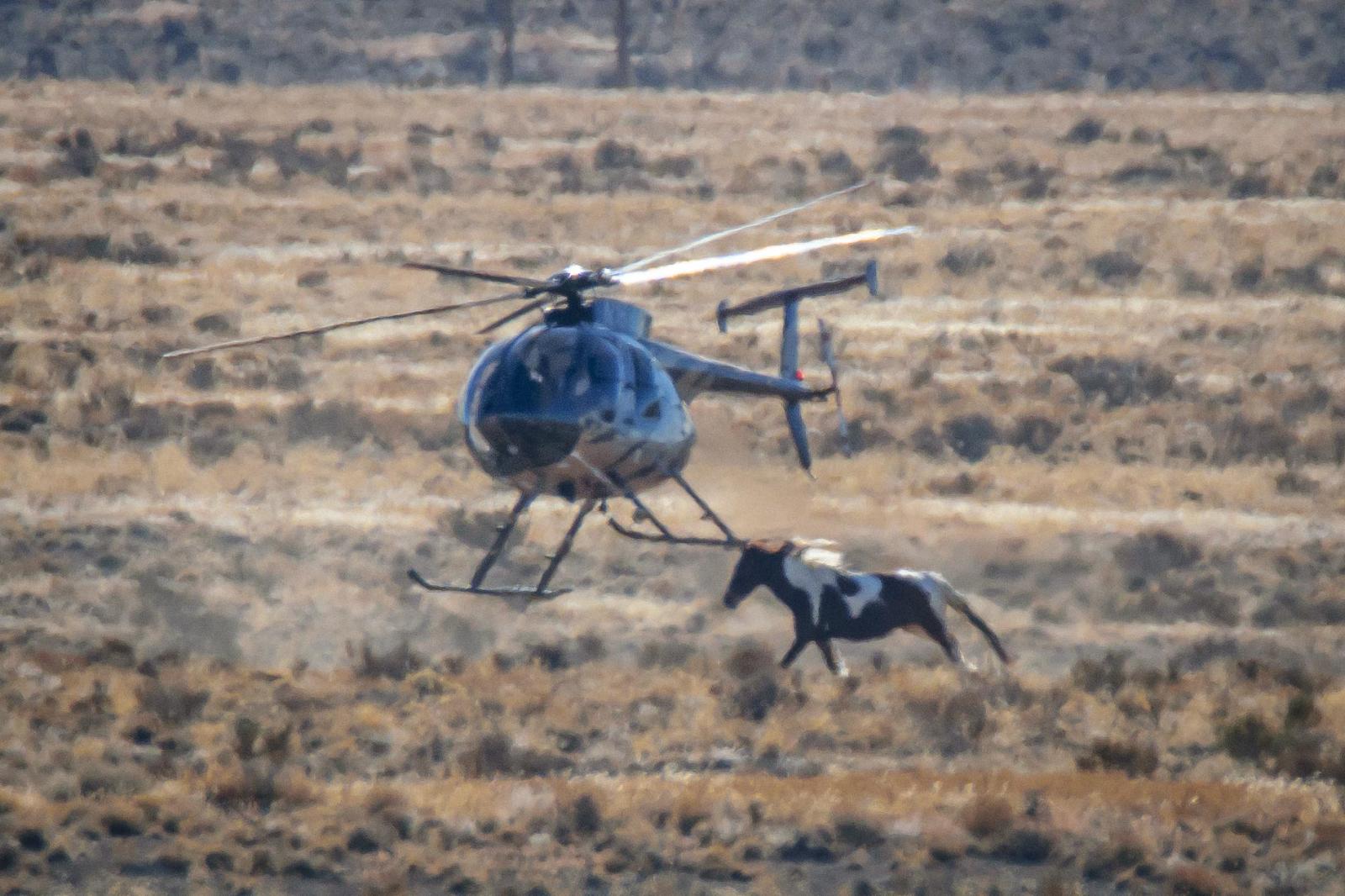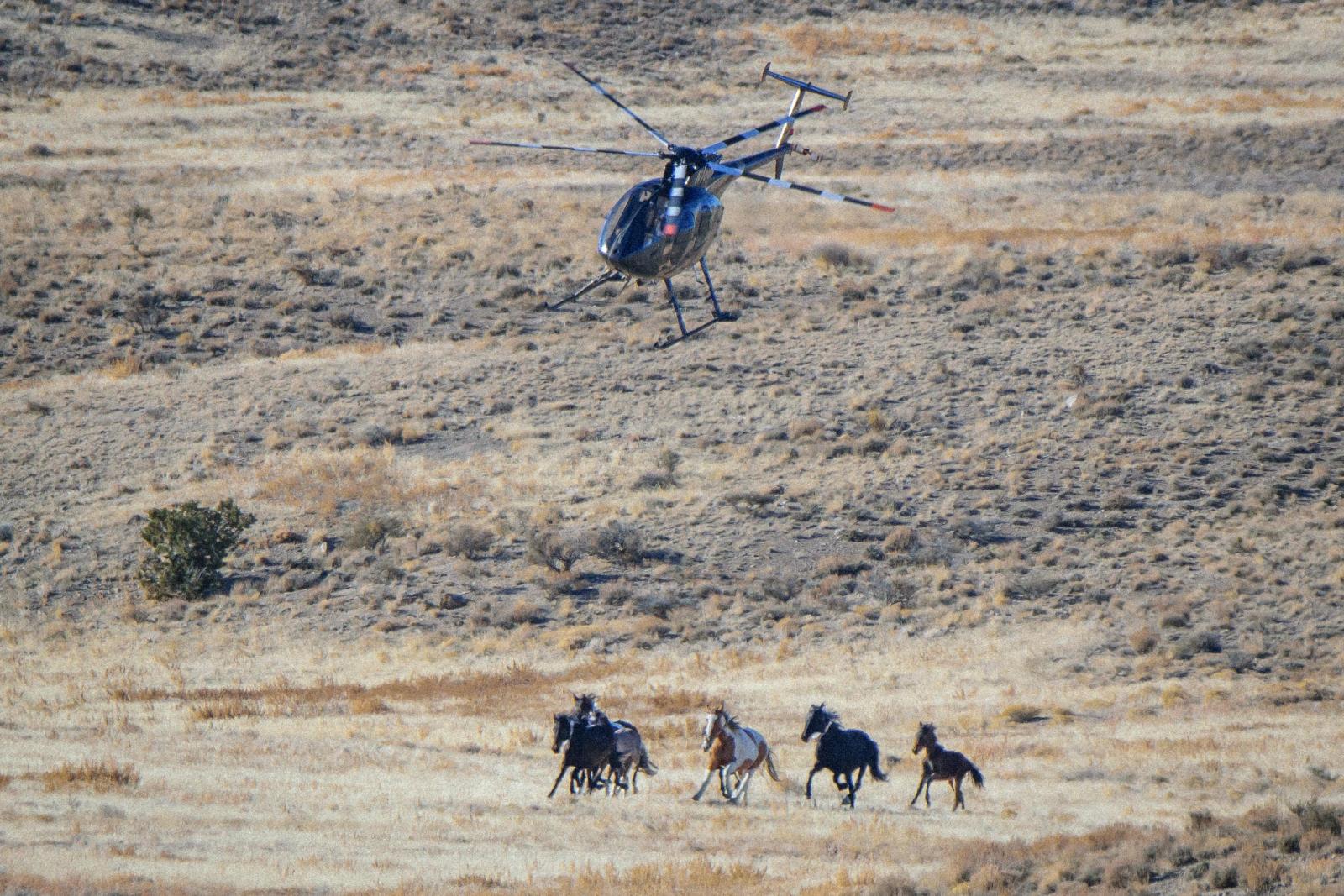The Conger roundup concluded on December 3, 2017 with a total of 111 wild horses captured.
This roundup is part of an ongoing "population control research" study conducted by the U.S. Geological Survey and Colorado State University to assess the impacts of gelding (castrating) stallions on individual behavior and herd dynamics. The overall project involves both the Conger HMA, where up to 70 percent of the stallion population will be castrated and the Frisco HMA, which is being used as a control population after the removal of 175 horses.
Of interest, the recent roundup was conducted in a manner that kept the family bands together, demonstrating that these capture operations can be conducted in a far more humane way than the way in which the BM routinely conducts them.
While AWHC welcomes research that will accurately document the impacts of castration on behavior, we are concerned that the plan to geld 75 percent of the stallions in the Conger HMA is likely to destroy the genetic viability and social integrity of the Conger herd. It's also very disheartening to think of the band stallions who will experience what the National Academy of Sciences describes as “loss of testosterone and consequent reduction in or complete loss of male-type behaviors necessary for maintenance of social organization, band integrity, and expression of a natural behavior repertoire."
Read the BLM daily reports here, and an on-the-ground report from day 1 below.
Report by Jim Schnepel, Wild Horses of America Foundation
SUMMARY: The Conger HMA is located about 75 miles west of Delta, Utah, and is fairly close to the Nevada line. The herd was chosen for a study on the effects of gelding. Per the Environmental Assessment, “The behavioral studies at Conger HMA (treatment population) would inform BLM about the behavioral effects of gelding a portion of a wild horses herd.”
“This gather* is in year two of a research study that is being conducted on wild horse behavior and ecology," said BLM West Desert District Wild Horse Specialist Trent Staheli. “It will examine the behavioral effects of gelding, population dynamics, fertility, reproductive rate, recruitment rate, age-specific survival and mortality, habitat selection, movements and habitat range among other things.” (Paragraph taken from BLM.gov.)
The horses are being rounded up by family groups, when possible, and moved to temporary holding together. There, each member of the family group is marked (glued-on tag) with the same identification number and then transported to BLM’s Delta holding facility where the stallions will be gelded. After a veterinarian gives clearance (expected to be in 7-10 days) the family groups will be taken back to the range and released in about the same area where each was originally found.
Many of the mares have radio/GPS collars (you can see some in the pictures, below) and the stallions have radio/GPS tags woven into their tales. These allow the researchers to more quickly locate, and follow, the individual family units.
You can read more about the study, and obtain the latest stats of the roundup, by visiting: https://www.blm.gov/programs/wild-horse-and-burro/herd- management/gathers-and-removals/utah/2017-conger-gather/conger-wild-horse- gather
The Environmental Assessment offers more detailed information about the study: https://eplanning.blm.gov/epl-front-office/projects/nepa/54504/75185/82849/Conger_Frisco_Research_EA_Final_5_27_16
You can learn more about how to visit this herd on this website:
http://www.wildhorsetourist.com/conger-mountain
*Gather: In recent years the BLM has gentled the terminology referring to helicopter removals. “Gathers” have replaced “roundups”. While the official title of this affair is a Gather, one wonders whether contracting with “Cattoor Livestock Roundup, LLC” supports the new messaging.
DAY 1 (sort of):
The roundup had been scheduled to begin on Tuesday, 28 December, but the BLM issued a delay, saying that due to weather conditions on the prior day the contractor had not settled on a trap site. However, they found one on Monday and rounded up 28 horses without observers from the public present.
We arrived at the Border Inn Casino, which sits on the line between Utah and Nevada, early on Wednesday morning. We joined the BLM convoy and drove east on Highway 50 for about 15 minutes, then headed north on a dusty road to the removal site.
After sitting in our vehicles for an hour or so with the heat on, we moved partway up a nearby hill to the designated viewing area and watched a group of 8 horses being pushed to the trap by Cattoor’s (the contractor) helicopter at around 8:10 am.
The viewing area was fairly distant from the trap site and from where the horses were being pushed into the entry wings of the trap, so taking pictures and observing were limited endeavors.
The second group of horses was pushed to the trap at about 9:20 am. There were 7 in the group, including one mare who escaped the wings of the trap and defiantly ran off to the North East. Despite repeated hazing by the helicopter she stayed true to her course and the helicopter finally was called off. She escaped and we hope that she reconnects with her family when they are returned to the range.
The final group that we observed included 4 horses.
All of the helicopter pushes, with the exception of the defiant mare, went smoothly. The contractor seemed intent on pushing the horses without too much force, possibly because the roundup is part of a research study. Most of the horses we observed were scored as 3s and 4s, with a couple of 2s.
We had to leave midday in order to get people back to the airport in Salt Lake City.






